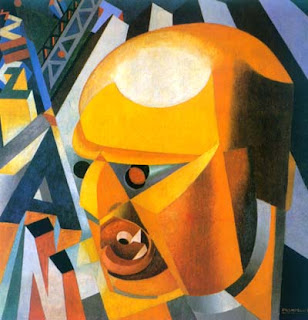A Futurist Artist
The founder of Futurism and its most influential personality was the Italian writer Filippo Tommaso Marinetti. Marinetti launched the movement in his Futurist Manifesto, which he published for the first time on 5 February 1909 in La gazzetta dell'Emilia, an article then reproduced in the French daily newspaper Le Figaro on 20 February 1909. He was soon joined by the painters Umberto Boccioni, Carlo Carrà, Giacomo Balla, Gino Severini and the composer Luigi Russolo.
Marinetti expressed a passionate loathing of everything old, especially political and artistic tradition. "We want no part of it, the past", he wrote, "we the young and strong Futurists!" The Futurists admired speed, technology, youth and violence, the car, the airplane and the industrial city, all that represented the technological triumph of humanity over nature, and they were passionate nationalists. They repudiated the cult of the past and all imitation, praised originality, "however daring, however violent", bore proudly "the smear of madness", dismissed art critics as useless, rebelled against harmony and good taste, swept away all the themes and subjects of all previous art, and gloried in science.
some of his work:Reference: Artist reference "Fillippo"
some work that was most likely Inspired by Filippo Tommaso Marinetti's work:
The Futurism art that was Inspired by Fillippo is From a Famous Graphic designer called David Carson who's website link and referenced Picture information is above. I like the modern take of a futurist look on his print, although it's for a Surf Film Festival client that he took on during 2011 it has an amazing resemblance towards the Futurism era of the early 20th century (1909-1916).
Constructivism Started in 20th Century Constructivism was the last and most influential modern art movement to flourish in Russia in the 20th century. It evolved just as the Bolsheviks came to power in the October Revolution of 1917, and initially it acted as a lightning rod for the hopes and ideas of many of the most advanced Russian artists who supported the revolution's goals.
A Constructivism Artist
Vladimir Tatlin was central to the birth of Russian Constructivism. Often described as a "laboratory Constructivist," he took lessons learned from Pablo Picasso's Cubist reliefs and Russian Futurism, and began creating objects that sometimes seem poised between sculpture and architecture. Initially trained as an icon painter, he soon abandoned the traditionally pictorial concerns of painting and instead concentrated on the possibilities inherent in the materials he used - often metal, glass, and wood. He wanted above all to bend art to modern purposes and, ultimately, to tasks suited to the goals of Russia's Communist revolution.
Reference:Artist Reference "Vladimir"
Reference: "Vladimir's tower"
The Image Reference: The Shard image Reference
The Shard is the largest skyscraper in the UK particularly London. It is a remarkable piece of architecture much like the constructivist Artist Vladimir Tatlin and his "Tatlin's Tower". I was confused when researching Tatlin's work as Information about him says he's a Constructivist artist and yet he's work is more Related to architecture and Designs similar to that.






No comments:
Post a Comment